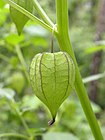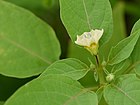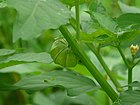Note: This is a project under development. The articles on this wiki are just being initiated and broadly incomplete. You can Help creating new pages.
Difference between revisions of "Physalis angulata"
| Line 1: | Line 1: | ||
| − | + | [[File:Physalis angulata (4871685240).jpg |thumb|right|'''Physalis angulata''']] | |
| + | '''Physalis angulata''' is an erect, herbaceous, annual plant belonging to the nightshade family Solanaceae. It reproduces by seed. Its leaves are dark green and roughly oval, often with tooth shapes around the edge. | ||
==Uses== | ==Uses== | ||
| − | {{Uses|}}, {{Uses|}}, {{Uses|}}, {{Uses| | + | {{Uses|Malaria}}, {{Uses|Toothache}}, {{Uses|Tepatitis}}, {{Uses|Rheumatism}}. |
==Parts Used== | ==Parts Used== | ||
| − | {{Parts Used|}}, {{Parts Used| | + | {{Parts Used|Fruits}}, {{Parts Used|Leaves}}. |
==Chemical Composition== | ==Chemical Composition== | ||
| + | It include Terpenoids, Carotenoids, Flavonoids and Polysaccharides. | ||
<ref name="chemical composition"/> | <ref name="chemical composition"/> | ||
==Common names== | ==Common names== | ||
| − | {{Common names | + | {{Common names|kn=|ml=Pee-inota-inodien |sa=|ta=|te=|hi=|en=Cutleaf Ground Cherry, dog tomato, cold cherry}} |
==Properties== | ==Properties== | ||
Reference: Dravya - Substance, Rasa - Taste, Guna - Qualities, Veerya - Potency, Vipaka - Post-digesion effect, Karma - Pharmacological activity, Prabhava - Therepeutics. | Reference: Dravya - Substance, Rasa - Taste, Guna - Qualities, Veerya - Potency, Vipaka - Post-digesion effect, Karma - Pharmacological activity, Prabhava - Therepeutics. | ||
===Dravya=== | ===Dravya=== | ||
| + | |||
===Rasa=== | ===Rasa=== | ||
| − | |||
===Guna=== | ===Guna=== | ||
| Line 29: | Line 31: | ||
==Habit== | ==Habit== | ||
| − | {{Habit|}} | + | {{Habit|Herbs}} |
==Identification== | ==Identification== | ||
===Leaf=== | ===Leaf=== | ||
| − | {{Leaf|||}}<ref name="Leaf"/> | + | {{Leaf|Simple|Ovate to ovate-oblong|Blunt or pointed or rounded (somewhat asymmetric) at base, pointed at tip. Leaves are wavy-toothed, rather dark dull green, 3-15 cm long, 2.5-10 cm wide, on long stalks 2-10 cm.}}<ref name="Leaf"/> |
===Flower=== | ===Flower=== | ||
| − | {{Flower||||}} | + | {{Flower|Bisexual|broadly ovate-heart-shaped|yellowish-green||Flowers are nearly 1 cm long, 1-2 mm.}} |
===Fruit=== | ===Fruit=== | ||
| − | {{Fruit|||| | + | {{Fruit|Simple Fruit|Ellipsoid|Fruit is about 1-1.8 cm long, within the balloon-like calyx; seeds about 1.7 mm long.|Yellowish|}} |
===Other features=== | ===Other features=== | ||
| Line 46: | Line 48: | ||
==Where to get the saplings== | ==Where to get the saplings== | ||
| − | |||
==Mode of Propagation== | ==Mode of Propagation== | ||
| − | {{Propagation|}} | + | {{Propagation|Seeds}}. |
==How to plant/cultivate== | ==How to plant/cultivate== | ||
| + | Physalis angulata, an emerging horticultural crop in western Mexico. The crop was introduced by the commercial demand for “milpero” a kind of husk tomato of small fruit and high commercial value. It is established in 0.5 ha monoculture plots. Its small-scale cultivation favors greater yields. | ||
<ref name="How to plant/cultivate"/> | <ref name="How to plant/cultivate"/> | ||
==Commonly seen growing in areas== | ==Commonly seen growing in areas== | ||
| − | {{Commonly seen| | + | {{Commonly seen|Tropical region}}. |
==Photo Gallery== | ==Photo Gallery== | ||
<gallery class="left" caption="" widths="140px" heights="140px"> | <gallery class="left" caption="" widths="140px" heights="140px"> | ||
| − | + | File:Physalis minima fruit from Kerala - 20090520.jpg | |
| + | File:Physalis angulata (4871072893).jpg | ||
| + | File:Physalis angulata (4871683978).jpg | ||
| + | File:Physalis angulata (2749690694).jpg | ||
</gallery> | </gallery> | ||
==References== | ==References== | ||
| + | |||
<references> | <references> | ||
| + | <ref name="chemical composition">[https://www.researchgate.net/publication/289144932_Chemical_constituents_of_whole_plant_of_Physalis_angulata_L#:~:text=Its%20main%20constituents%20include%20withanolides,Herb%20of%20Physalis%20angulata%20L. Chemical composition]</ref> | ||
| − | <ref name=" | + | <ref name="Leaf">[https://www.flowersofindia.net/catalog/slides/Cutleaf%20Ground%20Cherry.html Morphology]</ref> |
| − | |||
| − | |||
| − | <ref name="How to plant/cultivate">[ | + | <ref name="How to plant/cultivate">[https://www.researchgate.net/publication/282351125_Traditional_management_of_a_small-scale_crop_of_Physalis_angulata_in_Western_Mexico#:~:text=Our%20study%20examines%20Physalis%20angulata,horticultural%20crop%20in%20western%20Mexico.&text=The%20crop%20was%20introduced%20by,scale%20cultivation%20favors%20greater%20yields. Cultivation Details]</ref> |
| − | |||
</references> | </references> | ||
==External Links== | ==External Links== | ||
| − | * [ ] | + | * [https://npgsweb.ars-grin.gov/gringlobal/taxonomydetail.aspx?id=102388 Physalis angulata] |
| − | + | ||
| − | + | ||
[[Category:Herbs]] | [[Category:Herbs]] | ||
| − | [[Category: | + | [[Category:Solanaceae ]] |
Revision as of 16:24, 15 June 2020
Physalis angulata is an erect, herbaceous, annual plant belonging to the nightshade family Solanaceae. It reproduces by seed. Its leaves are dark green and roughly oval, often with tooth shapes around the edge.
Contents
- 1 Uses
- 2 Parts Used
- 3 Chemical Composition
- 4 Common names
- 5 Properties
- 6 Habit
- 7 Identification
- 8 List of Ayurvedic medicine in which the herb is used
- 9 Where to get the saplings
- 10 Mode of Propagation
- 11 How to plant/cultivate
- 12 Commonly seen growing in areas
- 13 Photo Gallery
- 14 References
- 15 External Links
Uses
Malaria, Toothache, Tepatitis, Rheumatism.
Parts Used
Chemical Composition
It include Terpenoids, Carotenoids, Flavonoids and Polysaccharides. [1]
Common names
| Language | Common name |
|---|---|
| Kannada | |
| Hindi | |
| Malayalam | Pee-inota-inodien |
| Tamil | |
| Telugu | |
| Marathi | NA |
| Gujarathi | NA |
| Punjabi | NA |
| Kashmiri | NA |
| Sanskrit | |
| English | Cutleaf Ground Cherry, dog tomato, cold cherry |
Properties
Reference: Dravya - Substance, Rasa - Taste, Guna - Qualities, Veerya - Potency, Vipaka - Post-digesion effect, Karma - Pharmacological activity, Prabhava - Therepeutics.
Dravya
Rasa
Guna
Veerya
Vipaka
Karma
Prabhava
Habit
Identification
Leaf
| Kind | Shape | Feature |
|---|---|---|
| Simple | Ovate to ovate-oblong | Blunt or pointed or rounded (somewhat asymmetric) at base, pointed at tip. Leaves are wavy-toothed, rather dark dull green, 3-15 cm long, 2.5-10 cm wide, on long stalks 2-10 cm. |
Flower
| Type | Size | Color and composition | Stamen | More information |
|---|---|---|---|---|
| Bisexual | broadly ovate-heart-shaped | yellowish-green | Flowers are nearly 1 cm long, 1-2 mm. |
Fruit
| Type | Size | Mass | Appearance | Seeds | More information |
|---|---|---|---|---|---|
| Simple Fruit | Ellipsoid | Fruit is about 1-1.8 cm long, within the balloon-like calyx; seeds about 1.7 mm long. | Yellowish | {{{6}}} |
Other features
List of Ayurvedic medicine in which the herb is used
Where to get the saplings
Mode of Propagation
How to plant/cultivate
Physalis angulata, an emerging horticultural crop in western Mexico. The crop was introduced by the commercial demand for “milpero” a kind of husk tomato of small fruit and high commercial value. It is established in 0.5 ha monoculture plots. Its small-scale cultivation favors greater yields. [3]
Commonly seen growing in areas
Photo Gallery
References
External Links
- Ayurvedic Herbs known to be helpful to treat Malaria
- Ayurvedic Herbs known to be helpful to treat Toothache
- Ayurvedic Herbs known to be helpful to treat Tepatitis
- Ayurvedic Herbs known to be helpful to treat Rheumatism
- Herbs with Fruits used in medicine
- Herbs with Leaves used in medicine
- Herbs with common name in Malayalam
- Herbs with common name in English
- Habit - Herbs
- Index of Plants which can be propagated by Seeds
- Herbs that are commonly seen in the region of Tropical region
- Herbs
- Solanaceae




